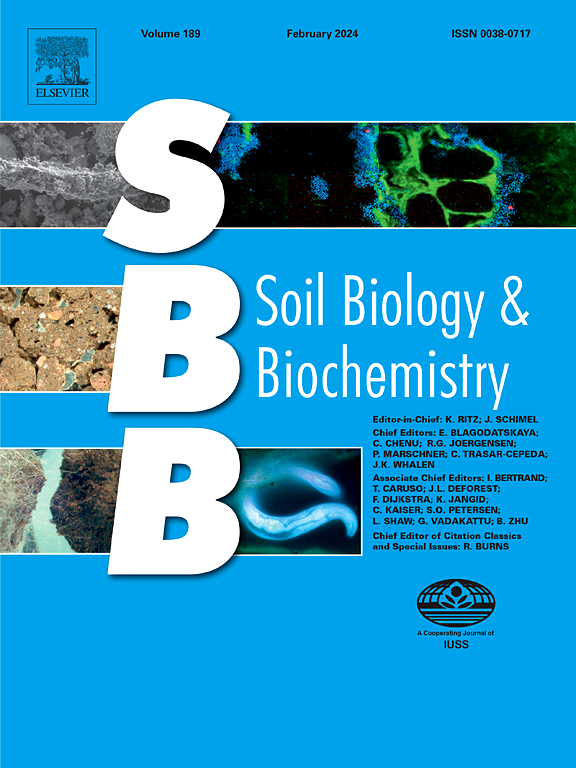The size-variation of microplastics alters plant nitrogen uptake by regulating soil gross nitrogen transformation rates
IF 10.3
1区 农林科学
Q1 SOIL SCIENCE
引用次数: 0
Abstract
The accumulation of microplastics (MPs) has been shown to affect ecosystem nitrogen (N) cycling. However, direct quantitative studies investigating how variations in MPs type and size affect soil N processes and plant N uptake are still lacking. Thus, a15N tracing was carried out to investigate the effects of variations in size (i.e., 1200–1400, 600–700, 120–150, 25–38 μm) of conventional polyethylene (PE-MPs) and biodegradable polylactic acid MPs (PLA-MPs) on the interactions between soil gross N transformation and plant N uptake rates. Results showed that variations in MPs size affected plant N uptake through regulating soil gross N transformation rates, with significant differences between PE-MPs and PLA-MPs. For PE-MPs, plant N uptake was significantly higher under the medium size (i.e., 600–700 μm) than other sizes. This was mainly due to the significantly higher nitrification rate (13 mg N kg−1 day−1) at 600–700 μm compared to other sizes, in turn, increasing NO3− supply to plants. Furthermore, decreased NH4+ immobilization (INH4) and increased dissimilatory NO3− reduction to NH4+ in 600–700 μm PE-MPs resulted in increasing NH4+ residence time, which ultimately could increase the available NH4+ to plants. For PLA-MPs, plant N uptake was significantly reduced by small size (i.e., 25–38 μm). Despite N mineralization rate (M) in 25–38 μm was 6–11 times higher than other sizes, INH4 was much higher than M, resulting in a stimulation of NH4+ residence time, in turn, inhibiting plant NH4+ uptake. Lower autotrophic nitrification rate due to decreased gene abundances of nitrification, as well as much higher NO3− immobilization rate suppressed plant NO3− uptake in 25–38 μm PLA-MPs. Our findings highlight that the extent to which MPs influence N processes depends on their type and size. The small-size degradable MPs can pose a major threat to plants, so the managements of degradable plastics requires special attentions.


微塑料的大小变化通过调节土壤总氮转化速率来改变植物对氮的吸收
微塑料(MPs)的积累已被证明会影响生态系统的氮(N)循环。然而,关于MPs类型和大小的变化如何影响土壤N过程和植物N吸收的直接定量研究仍然缺乏。因此,采用15N示踪研究了常规聚乙烯(PE-MPs)和可生物降解聚乳酸MPs (PLA-MPs)粒径(1200 ~ 1400、600 ~ 700、120 ~ 150、25 ~ 38 μm)对土壤总氮转化和植物氮吸收速率的影响。结果表明,MPs大小的变化通过调节土壤总氮转化速率影响植物对N的吸收,PE-MPs与PLA-MPs之间差异显著。对于PE-MPs,中等尺寸(即600 ~ 700 μm)下植株吸氮量显著高于其他尺寸。这主要是由于600 ~ 700 μm的硝化速率(13 mg N kg-1 day-1)显著高于其他尺寸,从而增加了植物的NO3 -供应。此外,在600 ~ 700 μm PE-MPs中,NH4+固定化(INH4)的减少和NO3 -对NH4+的异化还原的增加导致NH4+停留时间的延长,最终增加了植物的有效NH4+。对于PLA-MPs,植株氮素吸收量因尺寸较小(即25-38 μm)而显著降低。尽管25 ~ 38 μm的N矿化率(M)是其他粒径的6 ~ 11倍,但INH4浓度远高于M,刺激了NH4+的停留时间,抑制了植株对NH4+的吸收。在25-38 μm的PLA-MPs中,由于硝化基因丰度降低,自养硝化速率降低,而NO3 -固定速率过高,抑制了植物对NO3 -的吸收。我们的研究结果强调,MPs影响N过程的程度取决于它们的类型和大小。可降解小颗粒MPs对植物的危害较大,因此对可降解塑料的管理需要特别重视。
本文章由计算机程序翻译,如有差异,请以英文原文为准。
求助全文
约1分钟内获得全文
求助全文
来源期刊

Soil Biology & Biochemistry
农林科学-土壤科学
CiteScore
16.90
自引率
9.30%
发文量
312
审稿时长
49 days
期刊介绍:
Soil Biology & Biochemistry publishes original research articles of international significance focusing on biological processes in soil and their applications to soil and environmental quality. Major topics include the ecology and biochemical processes of soil organisms, their effects on the environment, and interactions with plants. The journal also welcomes state-of-the-art reviews and discussions on contemporary research in soil biology and biochemistry.
 求助内容:
求助内容: 应助结果提醒方式:
应助结果提醒方式:


